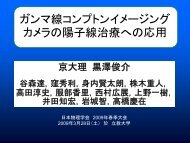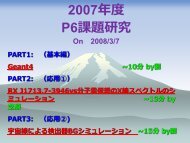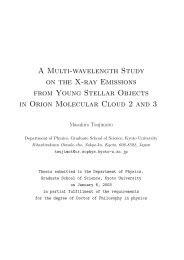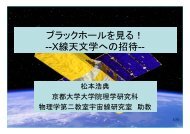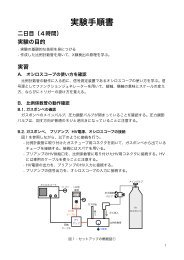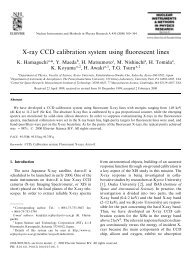X-ray Study of Low-mass Young Stellar Objects in the ρ Ophiuchi ...
X-ray Study of Low-mass Young Stellar Objects in the ρ Ophiuchi ...
X-ray Study of Low-mass Young Stellar Objects in the ρ Ophiuchi ...
You also want an ePaper? Increase the reach of your titles
YUMPU automatically turns print PDFs into web optimized ePapers that Google loves.
5.7. THE CATALOGUE OF X-RAY SOURCES IN <strong>ρ</strong> OPH 53(footnotes for Table 5.3)* Offset between <strong>the</strong> Chandra and nearest 2MASS sources. For sources hav<strong>in</strong>g a radio counterpart only, <strong>the</strong> <strong>of</strong>fsetbetween <strong>the</strong> Chandra and radio sources (André et al., 1987; Leous et al., 1991) are shown, which is <strong>in</strong>dicated by (R).† Radio sources. S, R, and L <strong>in</strong>dicate sources listed <strong>in</strong> André et al. (1987) (ROC), St<strong>in</strong>e et al. (1988) (SFAM), andLeous et al. (1991) (LFAM), respectively. Lp denotes possible radio sources <strong>in</strong> LFAM.‡ X-<strong>ray</strong> sources detected with ROSAT/PSPC (Casanova et al., 1995), ROSAT/HRI (Grosso et al., 2000), and ASCA(Kamata et al., 1997). “IKT” denotes Chandra sources already listed <strong>in</strong> Imanishi et al. (2001a).§ Source names used <strong>in</strong> <strong>the</strong> literature. Abbreviations for names are SR (Struve & Rudkjob<strong>in</strong>g, 1949), DoAr (Dolidze& Arakelyan, 1959), ROXs (Bouvier & Appenzeller, 1992), S (Grasdalen et al., 1973), YLW (<strong>Young</strong> et al., 1986), GY(Greene & <strong>Young</strong>, 1992), WL (Wilk<strong>in</strong>g & Lada, 1983), VSSG (Vrba et al., 1975), GSS (Grasdalen et al., 1973), Elias(Elias, 1978), BBRCG (Barsony et al., 1989), CRBR (Comerón et al., 1993), SKS (Strom et al., 1995), IRS (Wilk<strong>in</strong>get al., 1989), and ISO (Bontemps et al., 2001). For sources hav<strong>in</strong>g NIR counterpart only <strong>in</strong> <strong>the</strong> 2MASS catalog, wealternatively show <strong>the</strong> 2MASS source names.‖ Source classifications; I: class I, II: class II, III: class III, III c : class III candidate (Table 5 <strong>in</strong> Bontemps et al. 2001),BD: brown dwarf, BD c: brown dwarf candidate (Imanishi et al., 2001b), F: foreground star (Fest<strong>in</strong>, 1998). UnclassifiedNIR sources are <strong>in</strong>dicated by “?”, and sources with no NIR counterpart are called “unidentified sources”, labeled nodata po<strong>in</strong>t (...) <strong>in</strong> this column. For BD/BD cs, we show <strong>the</strong> available IR classification <strong>in</strong> Bontemps et al. (2001) <strong>in</strong><strong>the</strong> paren<strong>the</strong>ses.# Offset from a nearest NIR source <strong>in</strong> Greene & <strong>Young</strong> (1992).** Grosso (2001).†† Tsuboi et al. (2000).‡‡ The position <strong>of</strong> GY5 (Greene & <strong>Young</strong>, 1992) is slightly shifted (∼2. ′′ 3) from <strong>the</strong> 2MASS source.§§ A candidate <strong>of</strong> HH object (Gómez et al., 1998, see also §6.6.6).‖‖ From NIR spectroscopy, Wilk<strong>in</strong>g et al. (1999) derived for <strong>the</strong>se M dwarfs <strong>mass</strong>es higher than <strong>the</strong> hydrogen burn<strong>in</strong>glimit.






